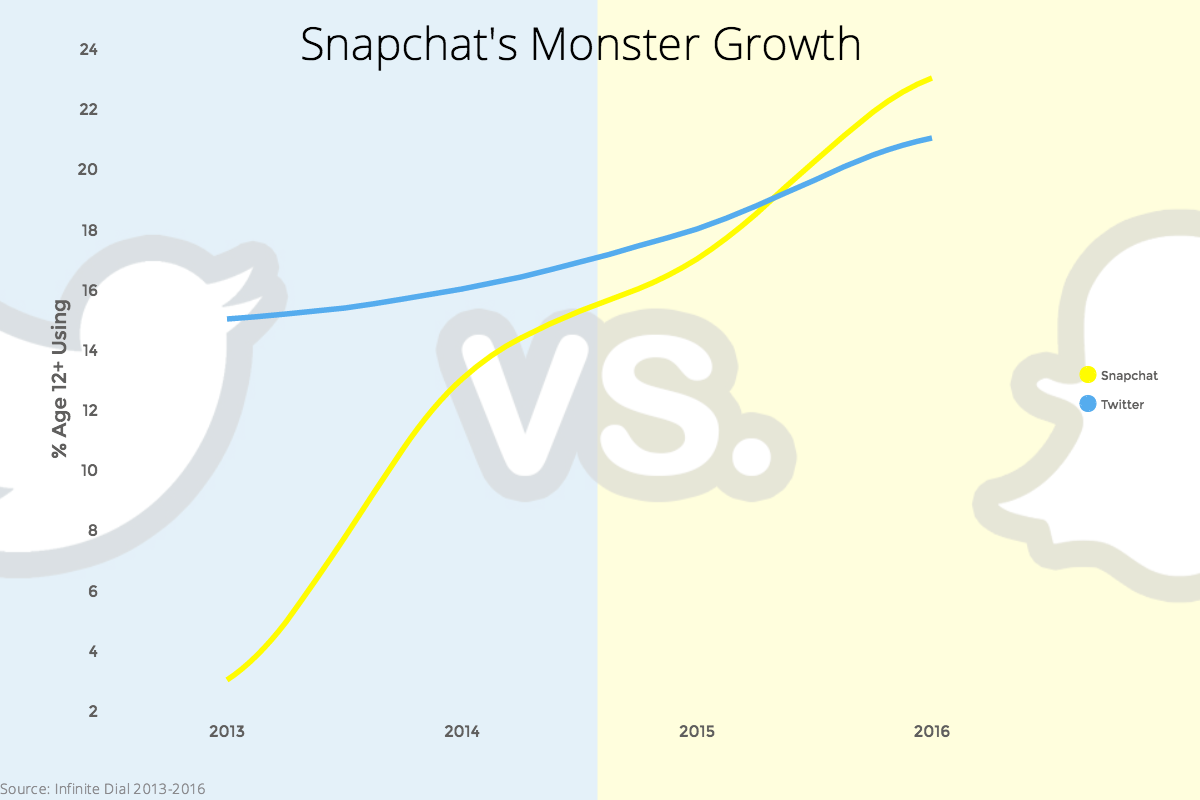Snapchat has more than established itself as a heavy weight in the social media scene over the years, and has shown some pretty impressive growth stats. Valued at $20 billion and with 150 million daily users, the app surpasses Twitter, Pinterest, and LinkedIn when it comes to regular engagement and is officially a household name (Haselkorn, 2016).

Yet companies haven’t embraced its marketing opportunities as much as they have Facebook and other similar social media platforms. Seeing as we are all aware of the value of video and picture content in advertising, it seems mad that Snapchat isn’t bombarded with adverts.
Well what are some of the benefits?
Apart from its rapid growth Snapchat utilises the video segment of marketing, with short and concise content to leave viewers asking questions and wanting more. This model is perfect for companies looking to increase their traffic to websites and blogs for example as they can advertise it for 10 seconds on Snapchat.
Another is that the production value of a Snapchat video is low. Part of the beauty of Snapchat is it’s every day videos by everyday people, no slick production values necessary. Making videos that fit this style will not only be cheap but could prove to be videos that Snapchat users can relate to.
The subtle approach is warranted in social media to be successful and Snapchat provides that. It allows marketers to find out what customers are interested in and then provide useful and enticing information in the form of their content (Ryan, 2016). If done correctly Snapchat can have a great positive impact on a business’s online profile.
So why aren’t companies biting?
Well firstly, Snapchat isn’t making it easy for them, much like Facebook a few years back they are primarily focused on enriching the user experience rather than factoring in much considerations for advertisers (Hanson, 2016). Great for the users, not so much for businesses. However, much like Facebook, Snapchat will be looking to monetise itself further with its continued growth and advertising will be an obvious choice. So for businesses, opportunity awaits.
On the reverse side, Snapchats format isn’t suited for many businesses and this may explain the lack of business users. Food and entertainment companies will do well from Snapchat as the visual aspect of their product is a huge part of what makes it sell. Most other businesses can’t get to grips with 10 second video or picture content unless they come up with a something that goes viral, not every day ideas unfortunately.
How can companies make the most of their Snapchat presence?
Studies have shown that content which sparks strong emotions such as humour, inspiration, sadness or fear are most likely to be shared and remembered (Phelps & Lewis et al, 2004). Cadbury has received good returns after sponsoring a Snapchat filter, adding a humorous element to one of their products in an interactive video.

Having mentioned the value of video content, having a snapchat channel would then be a logical step for companies looking to break into Snapchat. Very similar to a YouTube channel, users can subscribe to your channel and receive all your latest video content. However, due to Snapchats quick and to the point method open rates and video views tend to be higher and can be a great platform to provide teaser content, to encourage your viewers to search further.
Companies have also taken to enlisting famous Snapchat influencers with a large reach on Snapchat to promote their product within the videos they post. Sour Patch Kids adopted this approach and received 120,000 new Snapchat followers as a result. This is a great way to reach a large audience with very little effort for the organisation (Digital training academy, 2014).

If you need any more tips and pointers, Social Media Examiner provide every day users and businesses with all the information there is to know when it comes to using Snapchat effectively.
References
Digital Training Academy. (2014). Snapchat case study: Candy brand Sour Patch Kids have a sweet year on Snapchat. Available: http://www.digitaltrainingacademy.com/casestudies/2015/07/snapchat_case_study_candy_brand_sour_patch_kids_have_a_sweet_year_on_snapchat.php. Last accessed 27/02/2017.
Hanson, A. (2016). Why More Brands AREN’T Experimenting With Snapchat Read more at http://www.business2community.com/social-media/brands-arent-experimenting-snapchat-01441678#r49aKEhOeWvJicfu.99. Available: http://www.business2community.com/social-media/brands-arent-experimenting-snapchat-01441678#X1OdAKlO4xSxZO9f.97. Last accessed 27/02/2017.
Haselkorn, K. (2016). 5 Fatal Mistakes Businesses Are Making on Snapchat. Available: https://gofishdigital.com/snapchat-mistake-business/. Last accessed 27/02/2017.
Ryan, D. (2016). Understanding digital marketing: marketing strategies for engaging the digital generation. Kogan Page Publishers. P122.
Phelps, J. Lewis, R. Mobilio, L. Perry, D. Raman, N. (2004). Viral marketing or electronic word-of-mouth advertising: Examining consumer responses and motivations to pass along email. Journal of advertising research, 44(4), pp.333–348.
